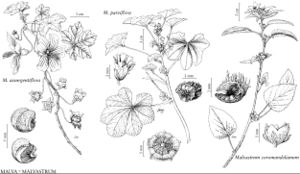Malvastrum coromandelianum
Bonplandia (Hanover) 5: 295. 1857.
Herbs, annual or perennial, 0.2–0.6 (–1) m, with 1 main-stem, freely branching in proximal 1/2. Stems erect or decumbent, hairs scattered, appressed, bilateral, (2–) 4-rayed, swollen-based, not sublepidote, hairs 1–3 mm. Leaves: stipules persistent, lanceolate, subfalcate to falcate, 3–6 × 0.5–1 mm, apex acuminate; petiole 10–20 (–40) mm; blade ovate to ± lanceolate, unlobed, (1.7–) 3–4 (–6.5) × (0.6–) 1.5–3 (–5.5) cm, 1.1–2.8 times longer than wide, 2.5–4.5 times longer than petiole, not greatly reduced on stem distally, base truncate to broadly-rounded to often wide-cuneate, margins dentate to serrate, apex acute, surfaces sparsely hairy, hairs bilateral, 2–4-rayed, stellate or with simple hairs on adaxial surface. Inflorescences axillary, solitary flowers, flowers sometimes congested towards branch tips; floral bracts absent. Pedicels 1–2 mm, to 3–5 mm in fruit; involucellar bractlets basally adnate to calyx for 0.5–1 mm, lanceolate, subfalcate, 4–6 × 0.6–1 mm, shorter than calyx lobes, apex acute.
Phenology: Flowering spring–frost at northern limit as an annual (cold-sensitive), nearly year-round when sufficiently wet and warm as a perennial.
Habitat: River floodplains and banks, disturbed areas, often in alkaline soil
Elevation: 0–100 m
Distribution

Fla., La., Tex., Mexico, West Indies, Central America, South America (to Argentina), worldwide from Tropics and subtropics to warm temperate zones
Discussion
Malvastrum coromandelianum is a widespread weed and the most common species in the genus; it is apparently native from Texas to Argentina. The introduced and widespread form has simple hairs on the adaxial surface of the leaf, while the native form has stellate hairs on that surface. Both forms are found in Texas. The species historically has been introduced in ballast in Alabama, Massachusetts, Pennsylvania, and New Jersey, but did not persist.
Subspecies coromandelianum occurs in the flora area and is a widespread weed in tropical and warm-temperate areas worldwide; the other two subspecies occur only in South America and on the Galapagos Islands.
Selected References
None.
